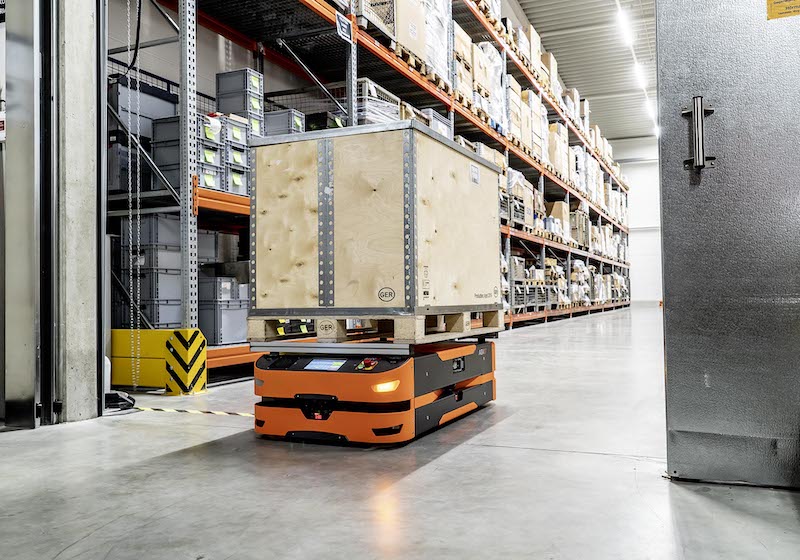SafeLog launches warehouse robots that can operate individually or in a ‘swarm’
SafeLog has launched warehouse robots that can operate individually or in a “swarm”, and says it offers customised automated guided vehicle solutions that have no need for a control station connection.
The company adds that the latest model of the SafeLog AGV L1 lifts loads of up to 1500 kg.
At present, many processes and systems for internal transport tasks in both, production and intralogistics are in a state of upheaval.
On the one hand, this is due to the currently applied distance and hygiene guidelines for employees as well as customers and suppliers; on the other hand, automation in general is undergoing change.
Especially in the field of transport and picking tasks within companies, automated guided vehicles (AGVs) have come into focus.

SafeLog – headquartered in the town of Markt Schwaben in Bavaria, Germany – offers solutions for these requirements with its AGV product family, which can be implemented in practically any environment. The portfolio currently consists of the three model sizes: AGV S2, AGV M3 and AGV L1, with more in development.
Agent-based control eliminates the need for a higher-level central control station and thus enables efficient and cost-effective operation of a few vehicles as well as deployment in swarm sizes of several hundred.
With the introduction of the SafeLog AGV L1 model in 2020, loads of up to 1500 kg can now be lifted or up to 3000 kg can be towed.
Mathias Behounek, managing director of SafeLog, says: “When developing our flexible and intelligent AGV models, we took the requirements going hand in hand with advancing automation into account.
“In doing so, we have benefited from our many years of experience in mapping and implementing intralogistic processes.”
As more and more in-house journeys and work steps are to be handled with the help of automated guided vehicles, the operational flexibility of SafeLog AGVs pays off.
Depending on the model and the task, they can be equipped with various superstructures. However, the devices are also suitable for coupling trailers and trolleys or lifting and transporting top loads.
No higher-level control centre necessary
The fewer vehicles are needed to manage a specific process, the more difficult it becomes for many manufacturers of automated guided vehicles to offer a profitable solution. This mainly results from the need for a higher-level control centre for vehicle control.
However, this purchase is only profitable for a larger number of vehicles, as the costs for hardware and software of the control centre as well as its project-specific programming are very high.
Behounek says: “Our AGVs have an agent-based control system that helps the individual vehicles communicate with each other and with the surrounding production and logistics facilities.
“The software is configured customer-specifically to the respective needs and ensures route coordination as well as task distribution through its swarm intelligence.”
In order to achieve the highest possible technical availability of the overall system, different navigation types are available, which can also be used in combination.
WLAN is used for communication between the AGVs, but the use of the new 5G standard is already in test. A dedicated app for mobile devices ensures a real-time system overview and displays the current operating status.
Expanding the range of applications
With the market launch of the AGV L1, SafeLog has rounded off the top end of its portfolio in terms of towing and lifting loads.
Behounek says: “With a height of only 340 mm, the AGV L1 is, for example, suitable for driving under pallets or pallet cages whose weight can be up to 1500 kg. The maximum trailer load is around 3000 kg.
“This allows us to handle a large part of the usual transport tasks. For safety reasons, the total height of AGV and transported goods must not exceed 2 m.”
The control system allows omni-directional travel, so that the AGV can move in any direction at any time. This increases the operational flexibility of the vehicles, as they can be maneuvered in the tightest of spaces.
In order to avoid an interruption of the material flow by trips to the charging station and to be able to map a 3-shift operation, it is possible to equip the loading and unloading points or work stations with charging contact plates, charging the AGV batteries during operation.
Behounek says: “Our claim is to respond to the requests and wishes of our customers with flexible and intelligent solutions.
“As a software-based system provider, we have extensive know-how to tackle this goal every day.”

